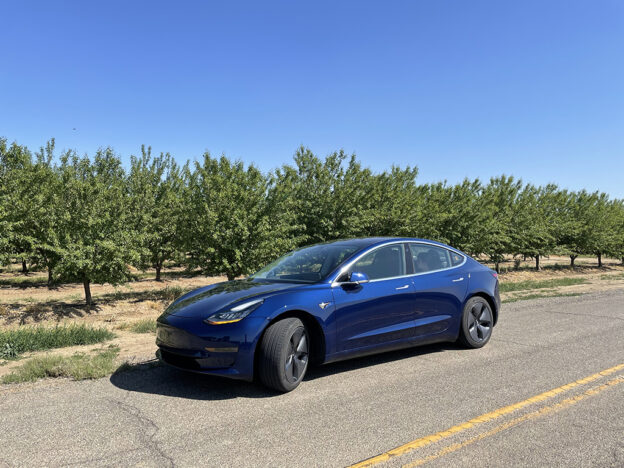April 2021. California.
Part 1 of my three-year review covers: Reliability inside and out; What could be improved; and What I like. Links to Parts 1-4 are at the bottom.
Our goal in buying cars has been finding a car that makes the least emissions, meets our needs for # of passengers and storage, and is reliable.
We traded in our 2010 Prius for the 2018 Model 3. Before getting the Prius we had a 2005 Corolla. We drove each Toyota for 8 or 9 years, and excluding oil changes only had service visits for the Prius to fix the squeaky dashboard – that problem was never solved. Otherwise both Toyotas were dependable. The Model 3 was our second EV – it joined the 2012 Rav4 EV that we’d been driving for 5 years.
We got our Model 3 in April 2018 and have logged 42,500 miles through the first three years. Has this car been reliable? Is it efficient? Does it have low emissions? I’ll cover those topics in four parts. Part 1 of this review discusses durability and reliability.
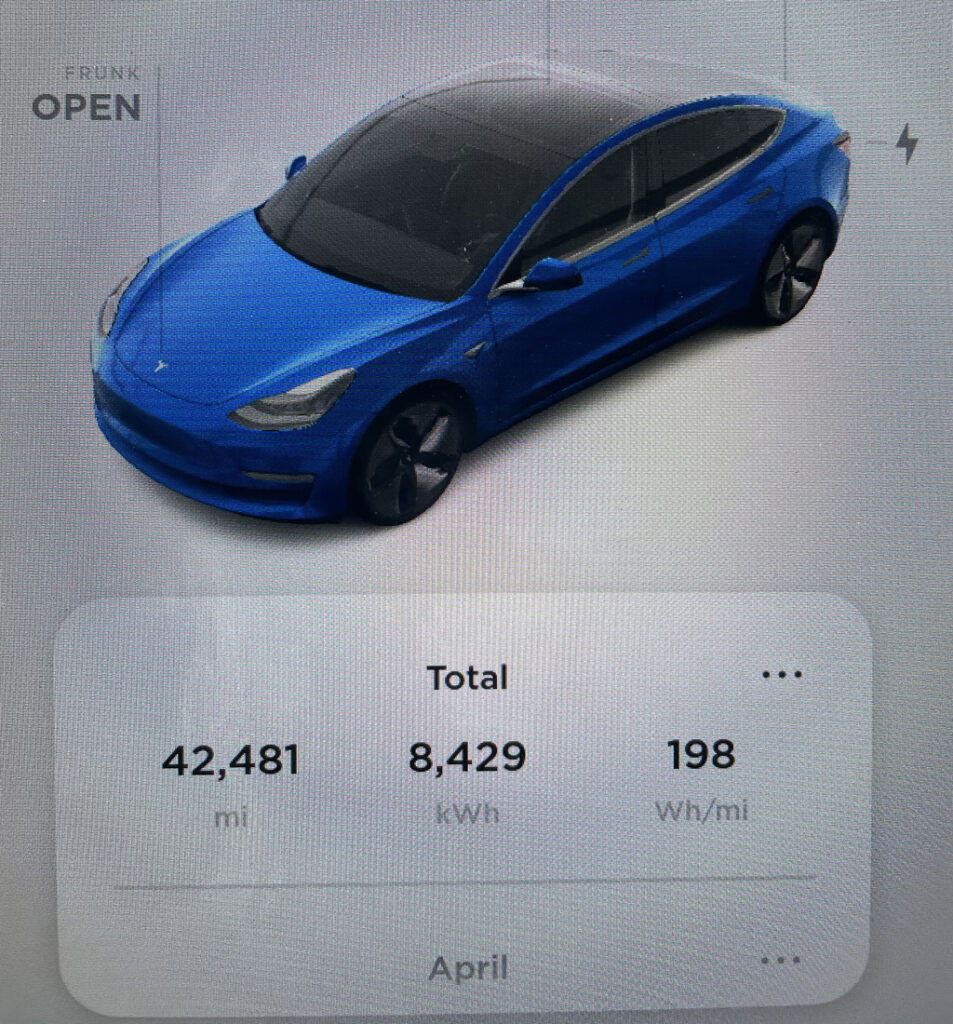
I) Exterior
The exterior has held up well. We got our Model 3 six months after deliveries began. Fit and finish were fine. The doors, trunk, frunk operate well. Paint good, side mirrors fold as designed.
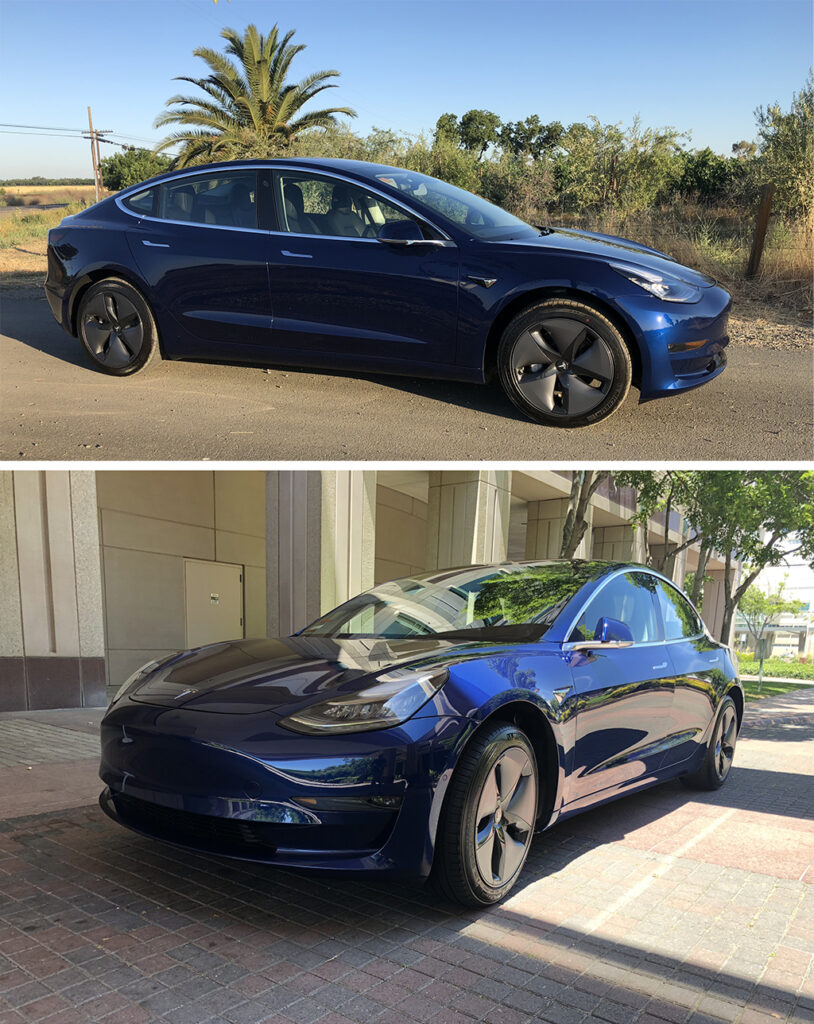
II) Interior
Cabin: The interior is holding up well. The cabin is quiet. Dashboard, seats, console, door trim etc all good and easy to clean. I added all weather mats front and back and in the trunk to make clean up a bit easier. The original high-gloss finish on the center console was high maintenance and highlighted dust too much. I bought a brushed black metal vinyl wrap, it was easy to install and looks better in my opinion. Dust is still there, just not as visible. New versions of the Model 3 and Model Y no longer have the high gloss finish on the center console.
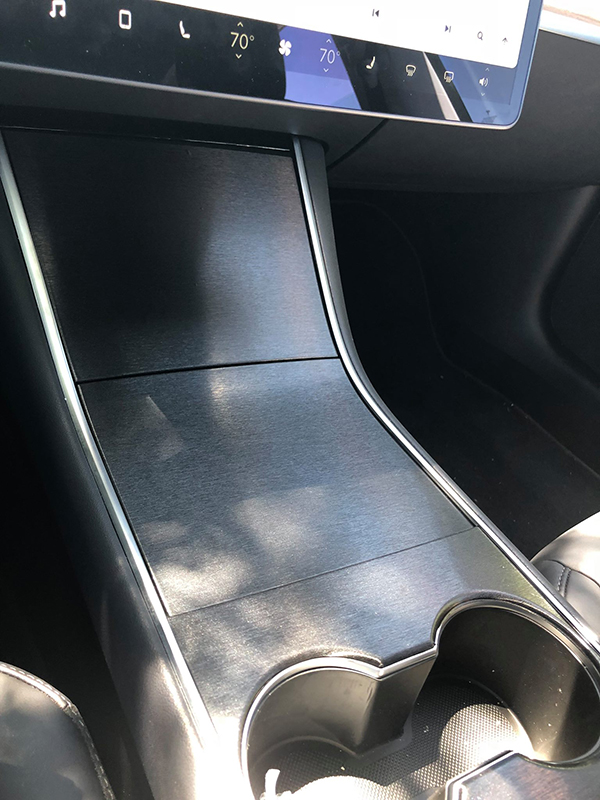
Driver’s seat: After three years in the Model 3 I still like the seat. Most of my driving is your typical home-work-home commute plus local errands. But I’ve also sat in the seat for extended periods of time on regional trips, on a week-long road trip over 2700 miles, and on another trip that included a full day in the driver’s seat while driving 800 miles to the Grand Canyon (and a week later doing that again on the way home). The ride is smooth and comfortable.
I’ve read complaints that the Model 3 ride is too firm. I don’t feel that way. Smoothest ride I ever experienced? 1972 Chrysler New Yorker, you floated down the road. But you couldn’t feel the road. Second best? International Harvester straight bed lumber truck with an air suspension seat. That seat also floated while maintaining a feel for the road. But I digress. In my opinion the Model 3 suspension gives you the right amount of feedback. It’s not too stiff, not too light.
A good comparison for the Model 3 seat is with the Model Y. I prefer the driver’s position in the Model Y. You sit up higher, it’s easier getting in and out of the car, and I think the Model Y seat is a bit softer. But, overall I like the Model 3 seat. In fact, I’ve created one driver profile setting called “Typing” that gives me the space I need to type on my laptop while waiting for my kids at school or soccer practice instead of getting out a folding chair like I used to do.
Center Screen: Resolution, brightness, image quality, and touch receptiveness of the center screen are still very good after 3 years. The organization is intuitive and user friendly.
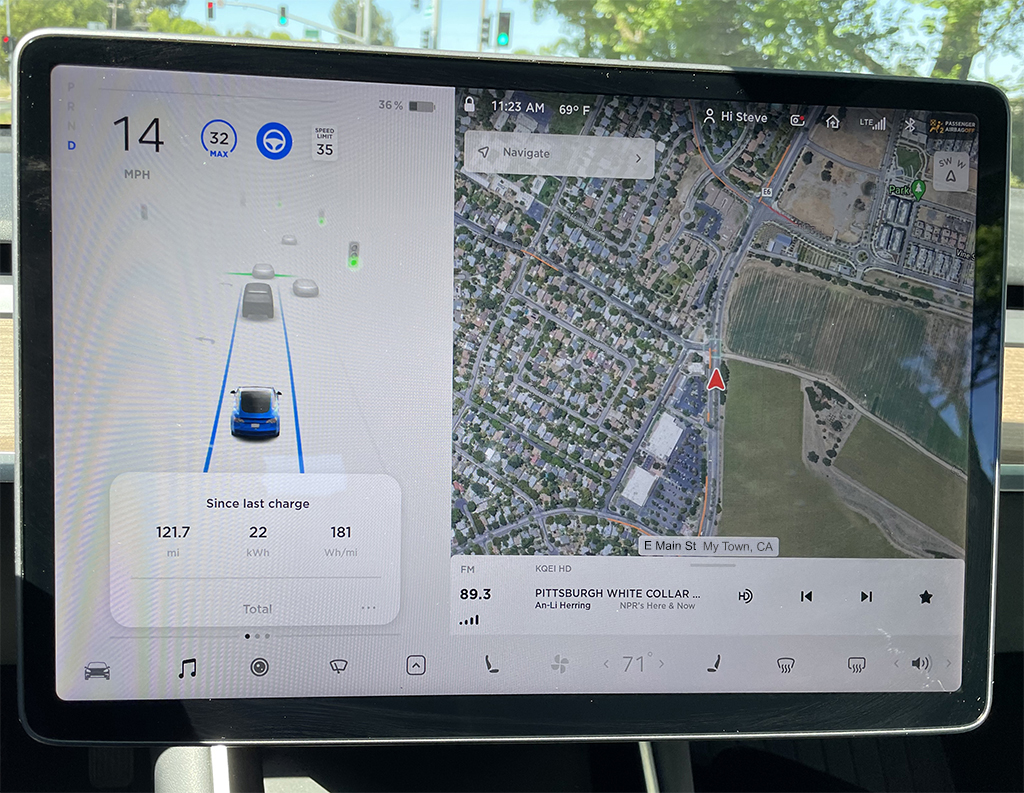
For those who haven’t seen this: The left 1/3 of the screen is dedicated to showing essential driving info. At the upper left is driving speed, then going across to the right: cruise control speed setting, Autopilot indicator, and speed limit of the road you’re driving. Below that you see your car (Blue in my case), other cars around you, and important traffic signs like traffic lights, stop signs, and speed limit signs. The lane you are driving in is highlighted in blue when Autopilot is active. In the example above I was driving on a two-lane road approaching a traffic light that was green.
Below the car is a widget block that includes several widgets you can access by swiping left, right, up and down. The example above shows the “Since last charge” odometer widget. You swipe through additional trip odometers, wiper controls, tire pressure, and active phone calls in this space.
The right 2/3 of the screen shows a satellite view of the roads you’re driving on, traffic, and your route if Navigate is active. The navigate menu is available by touching the grey block that says “Navigate”. Along the top of this portion of the screen you’ll see time, temperature, driver profile, Sentry Mode, Garage door opener, blue tooth, and cell signal strength. Driver profiles for seat and mirror settings can be associated with specific phones or cards.
Driver Controls: Again for those who haven’t see this – The main driver controls are accessed by touching icons that run across the bottom of the center screen in a ‘dock’. Touch the car icon on the left to adjust settings to your preference. This includes everything from steering wheel response, to side mirror settings, Autopilot, Navigate, and much more.
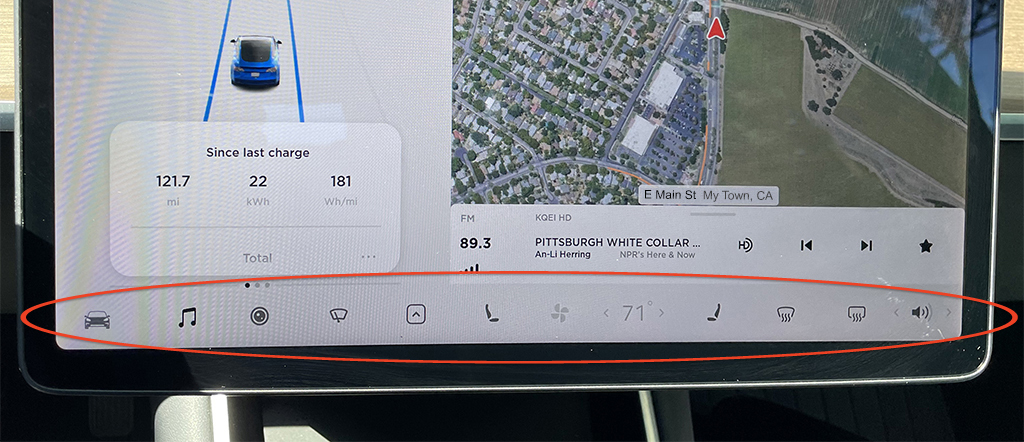
Controls are well organized and easy to find. Some car setting options can only be adjusted when the car is in Park. Music, climate controls (fan icon in the middle), and some others settings are always accessible. Phone, calendar and a few other items are brought up by touching the ‘up arrow’ icon in the dock. You can also press the right scroll wheel and use voice commands. Examples: “Call Joe Smith”; “Play Abbey Road”; “Navigate to 555 Main Street Midland, Illinois”; or “Take me to the nearest Supercharger”. Voice commands generally work well.
Some controls can be accessed through the screen or a hard wired button. For example, volume can be adjusted on the screen or more easily using the left scroll on the steering wheel. Another example: Wiper setting can be adjusted on screen or by pressing the end of the left drive stalk – that wipes the windshield once and brings up wiper controls in the widget block where you can adjust wiper settings. In my opinion driver controls are intuitive. Learning them in the Model 3 has been no different than learning how to adjust settings in other cars, perhaps easier in some cases.
Navigation: Navigation is dead simple and works very well. Voice commands work well and the mapping is good.
III) How the Car Drives
After three years the car feels solid, the ride is smooth. I love the way the car handles. I’m a slow driver – efficiency is more important to me than speed. But it’s good to know that power is there instantly and whenever needed. If I have to get around someone on the freeway or quickly get up to speed on an entrance ramp, I’m good.
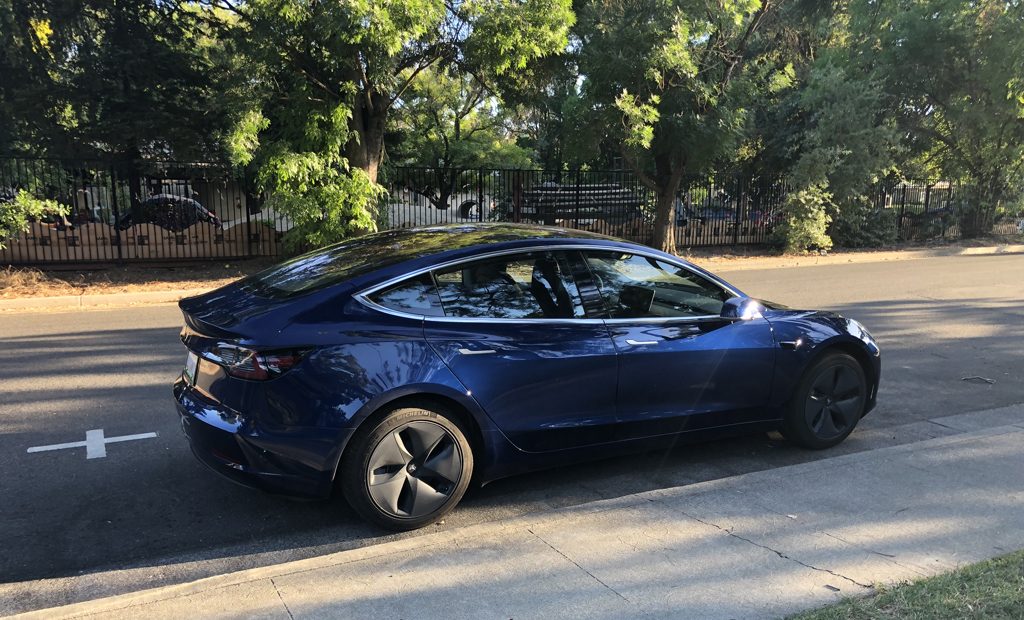
IV) Autopilot
I don’t use Autopilot that much for daily driving. On morning and evening commutes I usually prefer to drive myself. I believe that a driver who is paying attention, can see things happening further down the road. But the key point is ‘paying attention’. The huge advantage of Autopilot is that it’s always paying attention, it never gets distracted. For me Autopilot has been a big help on longer trips. It’s reassuring to know that 8 additional ‘eyes’ are watching the road at all times, especially for longer days on the road. In my opinion Autopilot has made our road trips more relaxing and safer.
In general I think that Autopilot is very good, but not perfect. There are limitations. Software updates improve functionality and the overall experience, but the system is still learning some of the rules of the road. Here’s 3 areas where Autopilot needs improving. (1) Shadows. Autopilot sometimes gets spooked by shadows (I’m running 2021.4.15), and this is a problem that needs to be fixed. Navigate on autopilot works very well driving, staying in your lane, detecting objects, and passing cars etc. But, the iteration of Autopilot I’m running gets spooked by shadows on the road and in some cases dramatically brakes the car. It’s as if Autopilot can’t tell the difference between shadows, cars, and objects and sometimes slows down suddenly and unexpectedly. (2) Lane merging. This needs to be improved. My car is overly cautious and when I get to merging lanes autopilot sometimes suddenly slows down to allow a car behind me to pass and get in front – something normal drivers don’t do. I turn off Autopilot when approaching lane merges. (3) Lane Centering. Autopilot is very good at keeping the car centered in it’s lane. What it doesn’t do is adjust its position based on the quality of the road or nearby traffic. I tend to give myself a little more room when passing large trucks. I don’t stay in the middle of the lane, but move over a bit to the left while passing. In contrast, Autopilot keeps the car dead center in its lane and sometimes it feels too close for me so I take over and give myself a bit more room in the lane.
All in all, Autopilot is remarkable. It never gets distracted, and is very good at many parts of driving. I find it very helpful on longer trips. Hopefully updates will address some of these issues. I paid $5,000 for EAP/FSD (that price was only available for a short time) and feel I’ve gotten my money’s worth. Is it worth $10,000? Good question.
V) Reliability and Durability
The car’s in good shape and the drive train works the same today as three years ago. Two minor issues were addressed at a service center after taking delivery: a piece of rubber trim on the drive stalk popped off, and carpet on the front passenger side was missing a fastener and wouldn’t stay in place.
Door handles: 2 were replaced at my house by Mobile Service. The Model 3 door handles are not powered like in the Model S. To open the door you push in the wider end of the handle and the thinner portion swings out to use as a handle to pull the door open. When you let go of the handle it swings in flush on its own. The initial design included a piece of plastic in the mechanism that created too much friction and some handles became sticky over time. The updated design doesn’t have this issue.
Rear view camera: this year it went on the fritz. My service center replaced a wiring harness in the trunk to fix the problem. While I was there I asked them to adjust the glove compartment – whenever I opened it I’d have to close it like 5 times for it to stay shut. All repairs have been done free of charge under warranty.
Only other issue I’ve had was a chipped windshield and glass roof that were fixed by Safelite for $75. Chipped windshields have happened with every car I’ve owned. The panoramic glass roof is higher risk compared to cars with a metal roof, but I like the open feel and wouldn’t swap for a metal roof.
In summary, the issues we’ve had were all covered by warranty and were not a hassle to get fixed. Overall our car has been very reliable.
VI) Things I’d like to see Improved:
Biggest pet peeve: I wish the car would open when the Tesla app is open on my phone. We also have a Model Y and Tesla solar panels. Since we got the Model Y, whenever I happen to swipe to the solar panels in the app and forget to swipe back to the 3 I can’t get in my car – this didn’t happen when we had just the Model 3 and solar panels. And of course this only seems to happen when I’m getting in the car with my hands full, so I have to set everything down, get out my phone, and swipe back to the Model 3 in the phone app. I’d really like that to be changed if possible.
The phone app gods must have heard us: an August 2021 Tesla phone app software update solved this problem. Thank goodness!!
Some Auto controls can be improved: Some driver controls that rely on sensors for automatic control can be improved. Two examples: (1) Auto-wipers: usually work, but sometimes in heavy rain I’d like the wipers to work a bit faster so I manually turn up the speed. Wiper settings can be accessed through the screen but I prefer pressing the button on the end of the left drive stalk, that initiates a single wipe of the windshield and calls up the wiper control widget on the lower left of the center screen so I can adjust the speed manually. Not a big deal, but I bet this can be improved. (2) High beam/lo beam: Works well for turning down the high beams when a car is approaching from the other direction. But sometimes while driving at night on local roads the headlights stay on low beam even if it’s dark, there’s no reflective objects around, and no cars coming in the other direction. And occasionally, pulling the drive stalk doesn’t turn on the brights until I pull the drive stalk several times. I asked the service center to look at that during my last visit and they said it’s working as designed. We have the same issue in our Model Y. Manually flipping the hi-beam / low-beam switch should always and immediately toggle lights between low and high whether or not lights are set on ‘Auto’.
Energy Use: The software system currently reports energy use while driving. The energy consumed to heat or cool the pack while parked, and energy used by Sentry Mode is not added to the total. I’d be surprised if that info isn’t available. We should have the option to toggle between total energy consumed vs. energy consumed on the road.
Rims and tires: this is the first car I’ve driven that has rims wider than the tires so I’ve gotten a bit of curb rash. Be careful pulling in and out of parking spots.
Autopilot: See above.
VII) What I like the Most
There’s a lot to like about this car. The two things I like the most: (1) Efficiency of the car. The low Cd combined with an efficient drive train makes for a very efficient car. (2) Long range of the car combined with Tesla’s nationwide Supercharging network makes for a good road tripping car.
Summary
We love this car. Love it. It’s been dependable and is a great ride. The efficiency is outstanding and we’ve been able to go on trips to see places we’ve wanted to visit for a long time. I highly recommend this car.
- Part 1: The basics.
- Part 2: Driving, Charging, and Battery Health
- Part 3: Energy use & Emissions
- Part 4: $$ (Coming soon)

